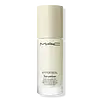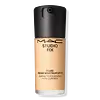Mac Cosmetics Hyper Real Serumizer™ Skin Balancing Hydration Serum Versus Mac Cosmetics Studio Fix Fluid SPF 15 24HR Matte Foundation + Oil Control
What's inside
What's inside
 Key Ingredients
Key Ingredients

 Benefits
Benefits

 Concerns
Concerns

 Ingredients Side-by-side
Ingredients Side-by-side

Water
Skin ConditioningDimethicone
EmollientButylene Glycol
HumectantGlycerin
HumectantNiacinamide
SmoothingTrisiloxane
Skin ConditioningOctyldodecyl Stearoyl Stearate
EmollientTrehalose
HumectantPaeonia Albiflora Flower Extract
TonicCholesterol
EmollientCeramide Ng
Skin ConditioningLinoleic Acid
CleansingSalicylic Acid
MaskingLactic Acid
BufferingGlycolic Acid
BufferingCitric Acid
BufferingAlgae Extract
EmollientSaccharomyces Lysate Extract
HumectantBetula Alba Bark Extract
MaskingCamellia Sinensis Leaf Extract
AntimicrobialThermus Thermophillus Ferment
Skin ConditioningLaminaria Saccharina Extract
Skin ProtectingSilybum Marianum Extract
Skin ConditioningCaffeine
Skin ConditioningBis-PEG-18 Methyl Ether Dimethyl Silane
EmollientAcetyl Glucosamine
Skin ConditioningSodium Hyaluronate
HumectantSorbitol
HumectantSodium Magnesium Silicate
PEG-8
HumectantSucrose
HumectantT-Butyl Alcohol
PerfumingPolyacrylate Crosspolymer-6
Emulsion StabilisingOleth-10
EmulsifyingCarbomer
Emulsion StabilisingAmmonium Acryloyldimethyltaurate/Vp Copolymer
Xanthan Gum
EmulsifyingHydrogenated Lecithin
EmulsifyingJojoba Wax PEG-120 Esters
Sodium Hydroxide
BufferingTromethamine
BufferingDi-C12-18 Alkyl Dimonium Chloride
Skin ConditioningSilica
AbrasiveParfum
MaskingBenzyl Salicylate
PerfumingLimonene
PerfumingLinalool
PerfumingCI 77891
Cosmetic ColorantSynthetic Fluorphlogopite
Tin Oxide
AbrasiveMica
Cosmetic ColorantCaprylyl Glycol
EmollientBHT
AntioxidantDisodium EDTA
Hexylene Glycol
EmulsifyingTocopheryl Acetate
AntioxidantMagnesium Ascorbyl Phosphate
AntioxidantPhenoxyethanol
PreservativeSodium Benzoate
MaskingWater, Dimethicone, Butylene Glycol, Glycerin, Niacinamide, Trisiloxane, Octyldodecyl Stearoyl Stearate, Trehalose, Paeonia Albiflora Flower Extract, Cholesterol, Ceramide Ng, Linoleic Acid, Salicylic Acid, Lactic Acid, Glycolic Acid, Citric Acid, Algae Extract, Saccharomyces Lysate Extract, Betula Alba Bark Extract, Camellia Sinensis Leaf Extract, Thermus Thermophillus Ferment, Laminaria Saccharina Extract, Silybum Marianum Extract, Caffeine, Bis-PEG-18 Methyl Ether Dimethyl Silane, Acetyl Glucosamine, Sodium Hyaluronate, Sorbitol, Sodium Magnesium Silicate, PEG-8, Sucrose, T-Butyl Alcohol, Polyacrylate Crosspolymer-6, Oleth-10, Carbomer, Ammonium Acryloyldimethyltaurate/Vp Copolymer, Xanthan Gum, Hydrogenated Lecithin, Jojoba Wax PEG-120 Esters, Sodium Hydroxide, Tromethamine, Di-C12-18 Alkyl Dimonium Chloride, Silica, Parfum, Benzyl Salicylate, Limonene, Linalool, CI 77891, Synthetic Fluorphlogopite, Tin Oxide, Mica, Caprylyl Glycol, BHT, Disodium EDTA, Hexylene Glycol, Tocopheryl Acetate, Magnesium Ascorbyl Phosphate, Phenoxyethanol, Sodium Benzoate
Water
Skin ConditioningMethyl Trimethicone
Skin ConditioningDimethicone
EmollientTrimethylsiloxysilicate
EmollientPEG-10 Dimethicone
Skin ConditioningButylene Glycol
HumectantIsododecane
EmollientPolyethylene
AbrasiveCetyl PEG/PPG-10/1 Dimethicone
EmulsifyingMagnesium Sulfate
Algae Extract
EmollientLaminaria Saccharina Extract
Skin ProtectingSodium Hyaluronate
HumectantSalix Nigra Bark Extract
Skin ProtectingTocopheryl Acetate
AntioxidantCaffeine
Skin ConditioningLecithin
EmollientHydrogenated Lecithin
EmulsifyingDisteardimonium Hectorite
StabilisingSilica
AbrasiveXanthan Gum
EmulsifyingDimethicone Crosspolymer
Emulsion StabilisingTriethoxycaprylylsilane
Dimethicone/PEG-10/15 Crosspolymer
Methoxy Amodimethicone/Silsesquioxane Copolymer
Skin ConditioningSorbitan Sesquioleate
EmulsifyingSalicylic Acid
MaskingSodium Citrate
BufferingLaureth-7
EmulsifyingMethyldihydrojasmonate
MaskingPropylene Carbonate
SolventAlumina
AbrasiveDipropylene Glycol
HumectantPentaerythrityl Tetra-Di-T-Butyl Hydroxyhydrocinnamate
AntioxidantBHT
AntioxidantPhenoxyethanol
PreservativeSorbic Acid
PreservativeChloroxylenol
AntimicrobialCI 77891
Cosmetic ColorantCI 77491
Cosmetic ColorantCI 77492
Cosmetic ColorantCI 77499
Cosmetic ColorantWater, Methyl Trimethicone, Dimethicone, Trimethylsiloxysilicate, PEG-10 Dimethicone, Butylene Glycol, Isododecane, Polyethylene, Cetyl PEG/PPG-10/1 Dimethicone, Magnesium Sulfate, Algae Extract, Laminaria Saccharina Extract, Sodium Hyaluronate, Salix Nigra Bark Extract, Tocopheryl Acetate, Caffeine, Lecithin, Hydrogenated Lecithin, Disteardimonium Hectorite, Silica, Xanthan Gum, Dimethicone Crosspolymer, Triethoxycaprylylsilane, Dimethicone/PEG-10/15 Crosspolymer, Methoxy Amodimethicone/Silsesquioxane Copolymer, Sorbitan Sesquioleate, Salicylic Acid, Sodium Citrate, Laureth-7, Methyldihydrojasmonate, Propylene Carbonate, Alumina, Dipropylene Glycol, Pentaerythrityl Tetra-Di-T-Butyl Hydroxyhydrocinnamate, BHT, Phenoxyethanol, Sorbic Acid, Chloroxylenol, CI 77891, CI 77491, CI 77492, CI 77499
 Reviews
Reviews

Ingredients Explained
These ingredients are found in both products.
Ingredients higher up in an ingredient list are typically present in a larger amount.
Algae Extract is a confusing name. This is because algae is an informal term for a group of 30,000 aquatic organisms that can photosynthesize.
The term 'algae extract' can refer to any one, or a blend of, the 30,000 types.
Algae is rich in antioxidants. Antioxidants help fight free-radicals. Free-radicals are molecules that may damage your skin cells, such as pollution.
Algae can also help with soothing and hydrating skin.
Many different types of algae have different benefits.
Learn more about Algae ExtractBHT is a synthetic antioxidant and preservative.
As an antioxidant, it helps your body fight off free-radicals. Free-radicals are molecules that may damage your skin cells.
As a preservative, it is used to stabilize products and prevent them from degrading. Specifically, BHT prevents degradation from oxidation.
The concerns related to BHT come from oral studies; this ingredient is currently allowed for use by both the FDA and EU.
However, it was recently restricted for use in the UK as of April 2024.
Learn more about BHTButylene Glycol (or BG) is used within cosmetic products for a few different reasons:
Overall, Butylene Glycol is a safe and well-rounded ingredient that works well with other ingredients.
Though this ingredient works well with most skin types, some people with sensitive skin may experience a reaction such as allergic rashes, closed comedones, or itchiness.
Learn more about Butylene GlycolCaffeine is most associated with coffee, tea, and cacao. In skincare, it helps with calming inflammation and is rich in antioxidants.
While caffeine is used to treat cellulite and and dark circles, further studies are needed to prove this. It has been believed to help with these skin conditions due to its ability to dilate blood vessels and increase blood flow.
Some studies are looking into caffeine's ability to protect against UV rays.
Learn more about CaffeineCi 77891 is a white pigment from Titanium dioxide. It is naturally found in minerals such as rutile and ilmenite.
It's main function is to add a white color to cosmetics. It can also be mixed with other colors to create different shades.
Ci 77891 is commonly found in sunscreens due to its ability to block UV rays.
Learn more about CI 77891Dimethicone is a type of synthetic silicone created from natural materials such as quartz.
What it does:
Dimethicone comes in different viscosities:
Depending on the viscosity, dimethicone has different properties.
Ingredients lists don't always show which type is used, so we recommend reaching out to the brand if you have questions about the viscosity.
This ingredient is unlikely to cause irritation because it does not get absorbed into skin. However, people with silicone allergies should be careful about using this ingredient.
Note: Dimethicone may contribute to pilling. This is because it is not oil or water soluble, so pilling may occur when layered with products. When mixed with heavy oils in a formula, the outcome is also quite greasy.
Learn more about DimethiconeHydrogenated Lecithin is created from the hydrogenation of lecithin (a group of phospholipids). Hydrogenation is a chemical reaction between hydrogen and another element.
This ingredient is an emollient and emulsifier. As an emollient, it helps soften skin by trapping moisture within. As an emulsifier, it prevents oil and water ingredients from separating.
We don't have a description for Laminaria Saccharina Extract yet.
Phenoxyethanol is a preservative that has germicide, antimicrobial, and aromatic properties. Studies show that phenoxyethanol can prevent microbial growth. By itself, it has a scent that is similar to that of a rose.
It's often used in formulations along with Caprylyl Glycol to preserve the shelf life of products.
Salicylic Acid (also known as beta hydroxy acid or BHA) is a well-known ingredient for treating skin that struggles with acne and clogged pores. It exfoliates both the skin's surface and deep within the pores to help clear out buildup, control oil, and reduce inflammation.
Unlike AHAs (alpha hydroxy acids), salicylic acid is oil-soluble. This allows it to penetrate into pores which makes it especially effective for treating blackheads and preventing future breakouts.
Salicylic acid is also known for its soothing properties. It has a similar structure to aspirin and can calm inflamed or irritated skin, making it a good option for acne-prone skin that is also sensitive.
Concentrations of 0.5-2% are recognized by the U.S. FDA as an over-the-counter topical acne product.
It can cause irritation and/or dryness if one's skin already has a compromised moisture barrier, so it's best to focus on repairing that before introducing this ingredient into your routine.
While salicylic acid does not increase sun sensitivity, it’s still important to wear sunscreen daily to protect your skin.
If you are looking for the ingredient called BHA or Butylated Hydroxyanisole, click here.
Learn more about Salicylic AcidSilica, also known as silicon dioxide, is a naturally occurring mineral. It is used as a fine, spherical, and porous powder in cosmetics.
Though it has exfoliant properties, the function of silica varies depending on the product.
The unique structure of silica enhances the spreadability and adds smoothness, making it a great texture enhancer.
It is also used as an active carrier, emulsifier, and mattifier due to its ability to absorb excess oil.
In some products, tiny microneedles called spicules are made from silica or hydrolyzed sponge. When you rub them in, they lightly polish away dead skin layers and enhance the penetration of active ingredients.
Learn more about SilicaSodium Hyaluronate is hyaluronic acid's salt form. It is commonly derived from the sodium salt of hyaluronic acid.
Like hyaluronic acid, it is great at holding water and acts as a humectant. This makes it a great skin hydrating ingredient.
Sodium Hyaluronate is naturally occurring in our bodies and is mostly found in eye fluid and joints.
These are some other common types of Hyaluronic Acid:
Learn more about Sodium HyaluronateTocopheryl Acetate is AKA Vitamin E. It is an antioxidant and protects your skin from free radicals. Free radicals damage the skin by breaking down collagen.
One study found using Tocopheryl Acetate with Vitamin C decreased the number of sunburned cells.
Tocopheryl Acetate is commonly found in both skincare and dietary supplements.
Learn more about Tocopheryl AcetateWater. It's the most common cosmetic ingredient of all. You'll usually see it at the top of ingredient lists, meaning that it makes up the largest part of the product.
So why is it so popular? Water most often acts as a solvent - this means that it helps dissolve other ingredients into the formulation.
You'll also recognize water as that liquid we all need to stay alive. If you see this, drink a glass of water. Stay hydrated!
Learn more about WaterXanthan gum is used as a stabilizer and thickener within cosmetic products. It helps give products a sticky, thick feeling - preventing them from being too runny.
On the technical side of things, xanthan gum is a polysaccharide - a combination consisting of multiple sugar molecules bonded together.
Xanthan gum is a pretty common and great ingredient. It is a natural, non-toxic, non-irritating ingredient that is also commonly used in food products.
Learn more about Xanthan Gum